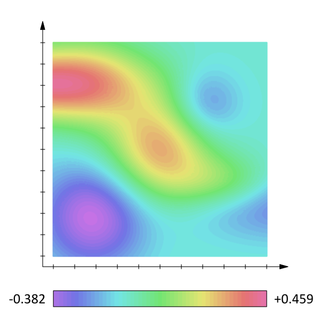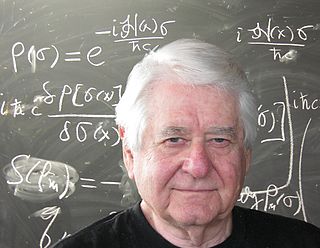Related Research Articles
In physical cosmology, cosmic inflation, cosmological inflation, or just inflation, is a theory of exponential expansion of space in the early universe. The inflationary epoch is believed to have lasted from 10−36 seconds to between 10−33 and 10−32 seconds after the Big Bang. Following the inflationary period, the universe continued to expand, but at a slower rate. The acceleration of this expansion due to dark energy began after the universe was already over 7.7 billion years old.

In physics, Kaluza–Klein theory is a classical unified field theory of gravitation and electromagnetism built around the idea of a fifth dimension beyond the common 4D of space and time and considered an important precursor to string theory. Gunnar Nordström had an earlier, similar idea. But in that case, a fifth component was added to the electromagnetic vector potential, representing the Newtonian gravitational potential, and writing the Maxwell equations in five dimensions.

In physics, gravity (from Latin gravitas 'weight') is a fundamental interaction which causes mutual attraction between all things with mass or energy. Gravity is, by far, the weakest of the four fundamental interactions, approximately 1038 times weaker than the strong interaction, 1036 times weaker than the electromagnetic force and 1029 times weaker than the weak interaction. As a result, it has no significant influence at the level of subatomic particles. However, gravity is the most significant interaction between objects at the macroscopic scale, and it determines the motion of planets, stars, galaxies, and even light.

In mathematics and physics, a scalar field is a function associating a single number to every point in a space – possibly physical space. The scalar may either be a pure mathematical number (dimensionless) or a scalar physical quantity.
In theoretical physics, the Einstein–Cartan theory, also known as the Einstein–Cartan–Sciama–Kibble theory, is a classical theory of gravitation similar to general relativity. The theory was first proposed by Élie Cartan in 1922. Einstein–Cartan theory is the simplest Poincaré gauge theory.
Since the 19th century, some physicists, notably Albert Einstein, have attempted to develop a single theoretical framework that can account for all the fundamental forces of nature – a unified field theory. Classical unified field theories are attempts to create a unified field theory based on classical physics. In particular, unification of gravitation and electromagnetism was actively pursued by several physicists and mathematicians in the years between the two World Wars. This work spurred the purely mathematical development of differential geometry.
In physics, the Brans–Dicke theory of gravitation is a competitor to Einstein's general theory of relativity. It is an example of a scalar–tensor theory, a gravitational theory in which the gravitational interaction is mediated by a scalar field as well as the tensor field of general relativity. The gravitational constant is not presumed to be constant but instead is replaced by a scalar field which can vary from place to place and with time.

John W. Moffat is a Danish-born British-Canadian physicist. He is currently professor emeritus of physics at the University of Toronto and is also an adjunct professor of physics at the University of Waterloo and a resident affiliate member of the Perimeter Institute for Theoretical Physics.

Carl Henry Brans is an American mathematical physicist best known for his research into the theoretical underpinnings of gravitation elucidated in his most widely publicized work, the Brans–Dicke theory.
String cosmology is a relatively new field that tries to apply equations of string theory to solve the questions of early cosmology. A related area of study is brane cosmology.
Scalar theories of gravitation are field theories of gravitation in which the gravitational field is described using a scalar field, which is required to satisfy some field equation.
In theoretical physics, particularly fringe physics, polarizable vacuum (PV) and its associated theory refers to proposals by Harold Puthoff, Robert H. Dicke, and others to develop an analogue of general relativity to describe gravity and its relationship to electromagnetism.
In theoretical physics, a scalar–tensor theory is a field theory that includes both a scalar field and a tensor field to represent a certain interaction. For example, the Brans–Dicke theory of gravitation uses both a scalar field and a tensor field to mediate the gravitational interaction.
Scalar–tensor–vector gravity (STVG) is a modified theory of gravity developed by John Moffat, a researcher at the Perimeter Institute for Theoretical Physics in Waterloo, Ontario. The theory is also often referred to by the acronym MOG.
In general relativity, the Newtonian gauge is a perturbed form of the Friedmann–Lemaître–Robertson–Walker line element. The gauge freedom of general relativity is used to eliminate two scalar degrees of freedom of the metric, so that it can be written as:
Alternatives to general relativity are physical theories that attempt to describe the phenomenon of gravitation in competition to Einstein's theory of general relativity. There have been many different attempts at constructing an ideal theory of gravity.

Vladimir Alekseevich Belinski is a Russian and Italian theoretical physicist involved in research in cosmology and general relativity. He worked at Landau Institute for Theoretical Physics from 1968 to 1989 and got his Habilitation degree at this Institute in 1980. As of 2016, he holds the permanent professor position at International Network of the Centers for Relativistic Astrophysics (ICRANet), Italy.
Horndeski's theory is the most general theory of gravity in four dimensions whose Lagrangian is constructed out of the metric tensor and a scalar field and leads to second order equations of motion. The theory was first proposed by Gregory Horndeski in 1974 and has found numerous applications, particularly in the construction of cosmological models of Inflation and dark energy. Horndeski's theory contains many theories of gravity, including General relativity, Brans-Dicke theory, Quintessence, Dilaton, Chameleon and covariant Galileon as special cases.
Jerzy Lewandowski is a Polish theoretical physicist who studies quantum gravity. He is a professor of physics at the University of Warsaw.
References
- 1 2 3 Horndeski, Gregory. "About the artist". Horndeski Contemporary. Retrieved January 17, 2022.
- ↑ Horndeski, Gregory Walter (1974-09-01). "Second-order scalar-tensor field equations in a four-dimensional space". International Journal of Theoretical Physics. 10 (6): 363–384. Bibcode:1974IJTP...10..363H. doi:10.1007/BF01807638. ISSN 0020-7748. S2CID 122346086.
- ↑ Kobayashi, Tsutomu; Yamaguchi, Masahide; Yokoyama, Jun'ichi (2011-09-01). "Generalized G-inflation: Inflation with the most general second-order field equations". Progress of Theoretical Physics. 126 (3): 511–529. arXiv: 1105.5723 . Bibcode:2011PThPh.126..511K. doi:10.1143/PTP.126.511. ISSN 0033-068X. S2CID 118587117.
- ↑ "Artist Gallery". Santa Monica BG Gallery. Retrieved January 17, 2022.
- ↑ "2020 New York Outsider Art Fair Booth B3_23". Horndeski Contemporary. Retrieved January 17, 2022.
- ↑ "G.W. Horndeski arxiv page". arxiv.org. Retrieved January 17, 2022.